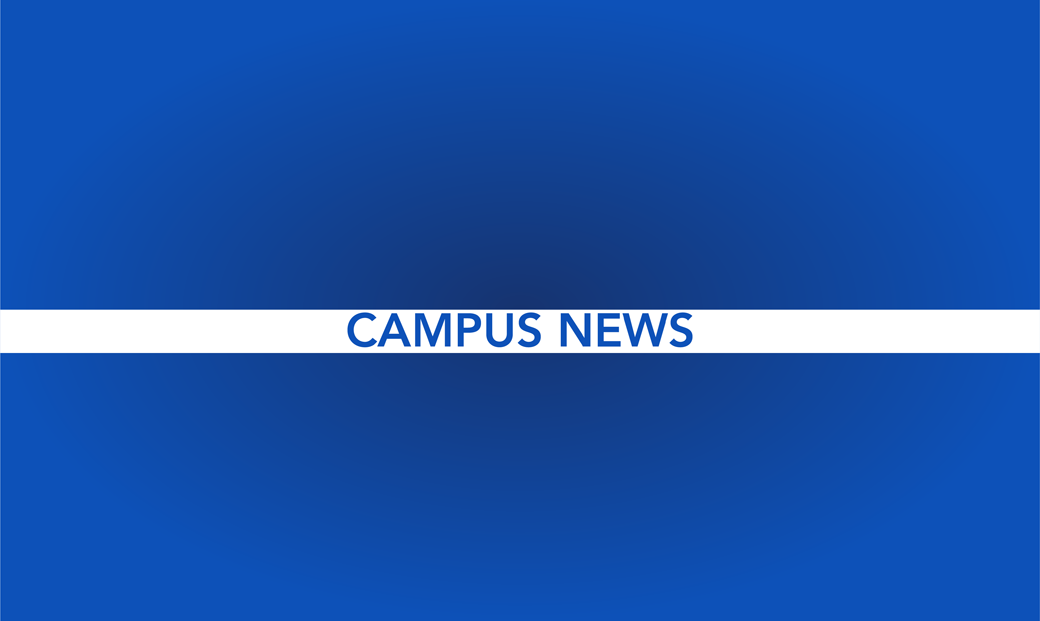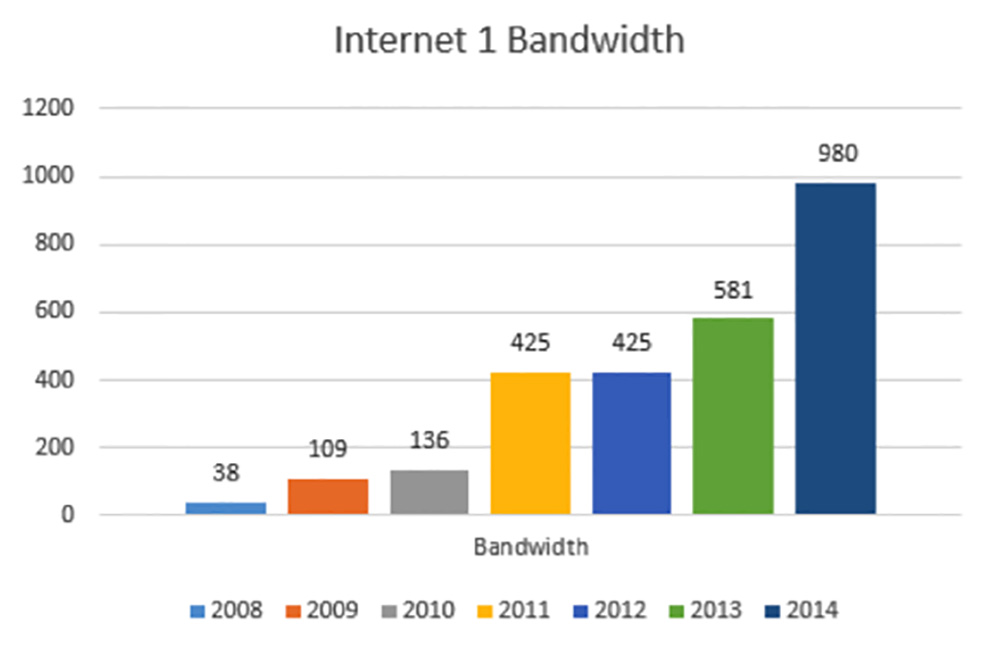
Keeping the connection: IT offers advice about campus wireless
First-year law student Hadier Jassim rolls her eyes at the mention of the blue Ethernet cord coiled up in her backpack. Jassim’s relationship with the University of South Dakota’s wireless network is a strained, often frustrating one that requires close proximity to nearby wall outlets just to access the Internet.
“It’s the same struggle every day. I’m so sick of that exclamation mark that shows up in the corner of my screen just to let me know that I can’t access anything,” she said.
The university’s wireless network handles more than 330,000 device connections each day, said Cheryl Tiahrt, USD’s director of Information Technology. Tiahrt attributes the growing demand to more smartphones and tablets on campus, which has lead to a 30 percent increase in Wi-Fi access points in the past three years.
“I don’t think we can ever get ahead of wireless demand,” Tiahrt said. “In newer devices, manufacturers are increasing battery life by decreasing signal strength, so we’re trying to compensate and re-evaluate access.”
As Tiahrt and information technology services respond to campus feedback on the network, students do not appear to agree on the quality of USD’s Wi-Fi. A spring survey conducted earlier this year included half of its 627 respondents rating USD’s wireless experience on campus as good or excellent.
But first-year Karli Tunender would say otherwise. Tunender recently had to turn in a midterm research paper late to a professor because she said she could not access the Internet to put the document in her Desire2Learn dropbox.
“I was panicking, because it was out of my hands,” she said. “My professor was understanding and gave me credit, but I’m sure I wasn’t the only one who was freaking out during midterms because the Internet wasn’t working.”
The cost of wifi
More than 8,000 people used over 15,000 devices on USD’s wireless network last year, according to data collected by IT services. To accommodate them and future users, USD has increased its bandwidth — the range of frequencies that are used to transmit wireless signal — by nearly half in the past year. Upgrading the data cabling of their internet infrastructure can also help boost the speed and reliability of their internet access.
Bandwidth is measured by megabits per second (mbps). USD went from using 136 mbps in 2010 to 980 mbps in 2014, an i ncrease that has in part to do with the university purchasing its bandwidth from the South Dakota Bureau of Information Technology, Tiahrt said.
ncrease that has in part to do with the university purchasing its bandwidth from the South Dakota Bureau of Information Technology, Tiahrt said.
The South Dakota Board of Regents provides the networking infrastructure for regental universities, but each institution decides its own bandwidth based on how much it needs and can afford.
The cost of bandwidth could be a deterrent for schools looking to increase their Internet speed because the bureau had a tendency to charge more than open market price, Tiahrt said.
After complaints were made to the SDBOR by university administration about the price of bandwidth, the rate dropped from $13.60 per megabit per month to $9.43 this year.
USD’s bandwidth is increased but not unlimited, said Kyle Gruhn, director of IT operations and development.
“As far as I know, there is no university that provides unlimited bandwidth. It has to be budgeted,” Gruhn said. “This is why we have people who monitor interference in the network, so it runs smoother.”
IT could limit the amount of bandwidth one device can use and then track down the owner if they are abusing their access, but Gruhn said this has not happened so far in the semester.
If a student was in a populated area of campus and needed to access D2L, the university could increase bandwidth for certain academic resources that it deemed has precedence. The I.D. Weeks Library and Muenster University Center are priority spots for IT.
First-year graduate student Kelly Schouten did not notice easier access to academic sites when she attempted to work on homework in the MUC on Monday afternoon. Schouten, who received her bachelor’s degree from Dordt College in Sioux Center, Iowa, said she has to use SDVisitor on campus because her password does not work with USD’s secure network.
“I admit I haven’t gone to the Help Desk, but I went to orientation and it didn’t make a difference,” Schouten said. “I never had this issue for my undergraduate. Granted, it was a much smaller school.”
Some students may not experience easier access to websites during the day, but Gruhn said the university increases the amount of bandwidth available to students after business hours to accommodate media-streaming sites, such as Netflix. This media alone consumes 50 to 70 percent of available bandwidth of one of USD’s two Internet connections.
What’s happening in IT
Students may see changes in December to their wireless access in residence halls. Tiahrt said the university is in the process of upgrading to a more advanced system that may be used by some computer models, such as a Mac Book Air, which could help streamline access.
A long-term change in IT includes moving the campus wireless to a more-widely used network, eduroam. It is an international roaming service used by higher institutions around the country and is already available to use on campus.
Gruhn said the transition to eduroam allows USD students to use secure wifi at other universities that support the same system, such as the University of Iowa.
“It’s about easy access for students. You could walk on another campus and immediately be able to log on to their wireless,” he said.
Increasing bandwidth will be an ongoing priority for the university, too, Tiahrt said. She said coverage will continue to be evaluated to prioritize expansion on campus. This could include more wifi access points outside, such as around the MUC or other areas of high foot traffic.
How to manage your wireless connection
First-year Andy Crawford prefers sitting in the link lab between the MUC and library, but said he cannot contend with the lack of Internet access. Crawford said he usually ends up heading to the library to find a better connection.
Other students like Crawford may have to play musical chairs around campus to find a solid Internet connection, but IT staff have a few suggestions for students struggling to maintain their wireless.
A factor that may affect access is the proximity to an access port and the total number of users connected to the same port. Tiahrt suggests students connect through a wired port for consistency. The Help Desk has patch cords, and each student can ask for a free cable by showing their student ID at the Help Desk.
Common issues in residence halls that disrupt the network begin from students using wireless hotspots and wireless printers. Gruhn said individuals attempting to create their own ad hoc wireless are major interferences to other people’s access, and students sometimes forget they are sharing their access more than they would in a typical household.
“The three people at home with your 11 devices between you versus the 8,000 people with 15,000 devices is not comparable, but people tend to want to compare it. ‘I never have this kind of trouble at home’ is not a fair statement, because well, yeah, you aren’t sharing access with 8,000 other people,” Gruhn said.
Devices such as tablets and smart phones decrease the signal strength of the Wi-Fi radio to conserve its battery life, so IT services suggests plugging-in, or making sure a device’s battery is fully charged to avoid wireless issues.
Tiahrt said one of the easiest ways to ease high traffic with the network is to turn wireless off on a device if it is not being used. A student may have their phone in their pocket, but if it is set to wireless, it continues to try to reconnect with the network as the student moves around campus.
Campus feedback can have a significant impact on the services IT provides, Gruhn said. The Help Desk this fall works on an average of 178 personal computers a week, but Tiahrt said IT services still struggles to hear back from students on when and where they have problems with wireless.
“It’s always important to get constructive feedback because we get a lot of calls of, ‘Well, it doesn’t work.’ ‘What doesn’t work?’ ‘I don’t know.’ If you can tell us you were in the library, on the second floor at 2 a.m. and you couldn’t get your laptop connected but you could get your phone, we can pinpoint it’s likely the device,” Gruhn said.


